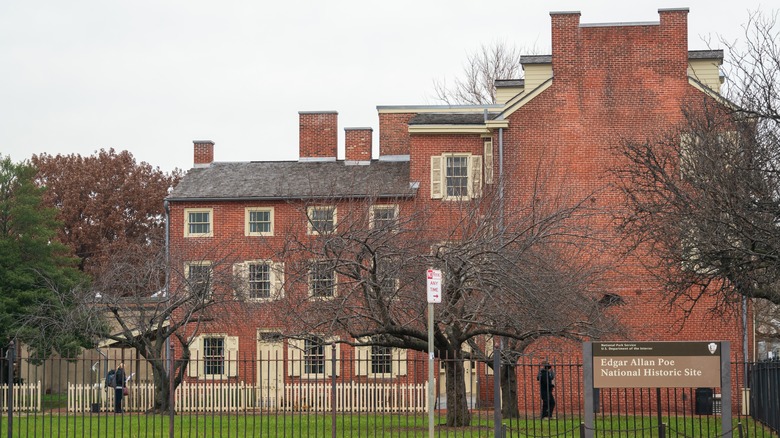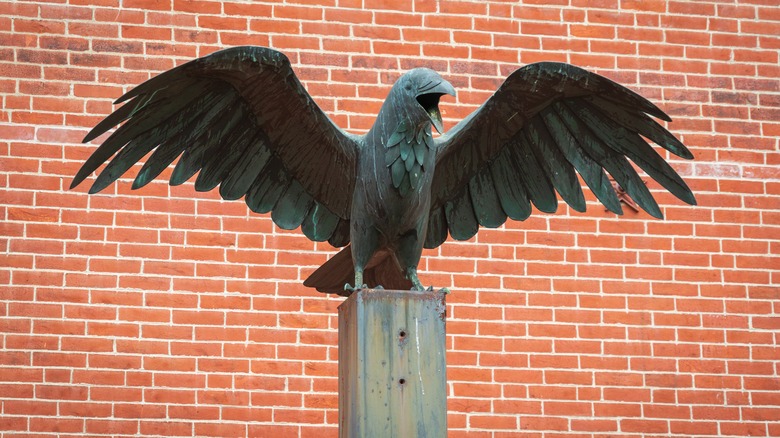Visit The Historic Home Of A Literary Legend In The Heart Of Philadelphia
If you've ever enjoyed science fiction, a detective story or horror, you can thank Edgar Allan Poe. The American literary giant is credited with helping create those genres. Literary nerds know that Poe's life rivaled his own stories in terms of its tragic turns, culminating in a death still shrouded in mystery 175 years later. While Boston-born Poe is linked most often with Massachusetts, Maryland, and Virginia, the writer passed six prolific years in Philadelphia.
Poe lived in Philadelphia from 1838 until 1844. He published a few of his most classic works in the city: "The Fall of the House of Usher," "The Murders in the Rue Morgue," and "The Gold-Bug." There are differing accounts as to whether he had four or five Philadelphia residences over the years, but it's clear financial hardship informed his living situations. Though Philadelphia is known for its well-preserved old streets and buildings, only one of his Philadephia homes remains today. It happens to be where he wrote some of his greatest works, though, and so makes a fitting national site.
On 7th Street, you can visit the Edgar Allan Poe National Historic Site, where he spent his last two years in Philly. It's operated by the National Parks Service, and admission is free. (Once again proving that Philly is one of the cheapest places to be a tourist.) The location is about a mile from noted spots like Franklin Music Hall, Franklin Square, and Reading Terminal Market, making it an ideal stop on a longer tour of the city.
The Edgar Allan Pоe National Historic Site is a three-floor museum of Poe's time here
The house on 7th Street was occupied by Edgar Allan Poe; his wife (and cousin) Virginia; his mother-in-law, Muddy; and Catterina their cat. Today it's a short 2-mile walk from one of Philly's most desirable neighborhoods. There is a green lawn out front, and Poe frequently spent time outside on the porch, according to one neighbor quoted by the National Parks Service. Entering the home's parlor, you step onto the original floors. They are quite creaky, too (a source of creative inspo, perhaps?) The first floor has a parlor and kitchen, which are sparse. At the time, the house would have been standard for Poe's economic class, lacking electricity and running water. The word "death" is carved into the kitchen doorway, though it is unknown if Poe carved the word himself.
The house's second floor holds Poe's room and a small room added after his time. Before moving to the house, Poe's wife was diagnosed with tuberculosis, which is contagious, so it's thought he slept on his own here in addition to writing. The third floor holds Virginia's room and her mother's room. The cellar is another popular space for tourists, reminiscent of his stories "The Black Cat," which he wrote in 1843, and "The Cask of Amontillado," which he wrote after leaving Philadelphia.
See historic exhibits about Poe and his time in Philly
The historic site has an exhibit area, with photos and multimedia to help tell the story of this legendary writer and his time in Philadelphia. Visitors can tour the home alone or with a guide. The home doesn't have many exhibits — even the most ardent fans on Tripadvisor concede that it's probably more for the literary-minded than for regular tourists. But you can still learn a lot about Edgar Allan Poe's life from the furnishings and relatively well-preserved interiors.
Poe persevered through many challenges during his life. He had to leave school because he couldn't afford tuition, and financial hardship followed him for the rest of his life. Despite the success he enjoys today, much of that came after his death. Dealing with his wife's illness and having trouble getting work and paid, he filed for bankruptcy here, listing only a few belongings and selling what he could. The humble house shows how Poe lived in his day and reminds visitors that he wasn't always a household name.
Inside the house, you can imagine Poe amidst his challenges toiling away at such classics as "The Black Cat" and "The Tell-Tale Heart," which he wrote here. You will indeed walk in the footsteps of a giant when visiting.


